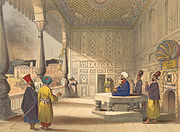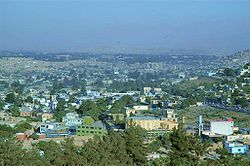|
|
|
| |
| |
| |
 |
About Kabul |
|
|
| |
Kabul (Pashto/Persian: ???? Kabul; IPA: [k??'bol];[2] archaic Caubul), is the capital and largest city of Afghanistan, located in the province of Greater Kabul. According to a 2009 census, it has a population of 3,568,500.[3][4]
It is an economic and cultural centre, situated 5,900 ft (1,800 m) above sea level in a narrow valley, wedged between the Hindu Kush mountains along the Kabul River. The city is linked with Ghazni, Kandahar, Herat and Mazar-e Sharif via a circular highway that stretches across the country. It is also the start of the main road to Jalalabad and, further on, Peshawar, Pakistan.
Kabul's main products include munitions, cloth, furniture and beet sugar, but since 1978, a state of nearly continuous war has limited the economic productivity of the city. Economic productivity has improved since the establishment of the Islamic Republic of Afghanistan in 2001.[5]
Kabul is over 3,000 years old; many empires have long fought over the city for its strategic location along the trade routes of Southern and Central Asia. In 1504, Babur captured Kabul and used it as his headquarters until 1526, before his conquest of India. In 1776, Timur Shah Durrani made it the capital of modern Afghanistan.[6] Since the Soviet war in Afghanistan in the 1980s, the city has been a constant target of destruction by rebels or militants. It is currently in the early phases of reconstruction.[7] New construction projects are being implemented as attempts at modernizing the city. |
.jpg) |
|
| |
History
Nadir Shah of Persia invaded and captured the city in 1738 but was assassinated nine years later. Ahmad Shah Durrani, an Afghan military commander and personal bodyguard of Nader, took the throne in 1747, asserted Pashtun rule and further expanded his new Afghan Empire. His son Timur Shah Durrani, after inheriting power, transferred the capital of Afghanistan from Kandahar to Kabul in 1776.[35] Timur Shah died in 1793 and was succeeded by his son Zaman Shah Durrani. The first European to visit Kabul was the 18th century English traveller George Foster, who described it as "the best and cleanest city in Asia".[10]
In 1826, the kingdom was claimed by Dost Mohammad Khan and taken from him by the British Indian Army in 1839, who installed the unpopular Shah Shuja. An 1841 local uprising resulted in the loss of the British mission and the subsequent Massacre of Elphinstone's Army of approximately 16,000 foreign forces, which included civilians and camp followers on their retreat from Kabul to Jalalabad. In 1842 the British returned, plundering Bala Hissar in revenge before fleeing back to British India (now Pakistan). Dost Mohammed returned to the throne.
The British and Indian forces invaded in 1878 as Kabul was under Sher Ali Khan's rule, but the British residents were again massacred. The invaders again came in 1879 under General Roberts, partially destroying Bala Hissar before retreating to British India (Pakistan). Amir Abdur Rahman Khan was left in control of the country.
In the early 20th century King Amanullah Khan rose to power. His reforms included electricity for the city and schooling for girls. He drove a Rolls-Royce, and lived in the famous Darul Aman Palace. In 1919, after the Third Anglo-Afghan War, Amanullah announced Afghanistan's independence from foreign affairs at Eidgah Mosque. In 1929 Ammanullah Khan left Kabul due to a local uprising orchestrated by Habibullah Kalakani and Ammanullah's brother, Nader Khan, took control over the nation. King Nader Khan was assassinated in 1933 and the throne was left to his 19-year-old son, Zahir Shah, who became the long lasting King of Afghanistan. |
 |
|
| |
Reconstruction and Developments
As of October 2007, there are approximately 16 licensed banks in Kabul: including Da Afghanistan Bank, Afghanistan International Bank, Standard Chartered Bank, Kabul Bank, Azizi Bank, Punjab National Bank, Pashtony Bank, Afghan United Bank, Habib Bank and others. Western Union offices are also found in many locations throughout the city.
A small sized indoor shopping mall (Kabul City Center) with a 4-star (Safi Landmark) hotel on the top six floors opened in 2005. A 5-star Serena Hotel also opened in 2005. Another 5-star Marriott Hotel is under construction. The landmark InterContinental Hotel has also been refurbished and is in operation. Modern apartment buildings are also being built across Kabul, as part of the attempt to modernize the city.
An initial concept design called the City of Light Development, envisioned by Dr. Hisham N. Ashkouri, Principal of ARCADD, Inc. for the development and the implementation of a privately based investment enterprise has been proposed for multi-function commercial, historic and cultural development within the limits of the Old City of Kabul along the Southern side of the Kabul River and along Jade Meywand Avenue,[70] revitalizing some of the most commercial and historic districts in the City of Kabul, which contains numerous historic mosques and shrines as well as viable commercial activities among war damaged buildings. Also incorporated in the design is a new complex for the Afghan National Museum. Dr. Ashkouri has signed a Memorandum of Understanding with His Excellency Ambassador Said Tayeb Jawad in Washington, DC to undertake this project and to develop it for actual implementation over the next 20 to 25 years. Dr. Ashkouri has presented the City of Light Plan to President Karzai and has received a letter of support from the President and the Minister of Urban Development in support of this projectís development. |
 |
|
| |
|
| |
|
|
|
|
|
|
|
| |
|